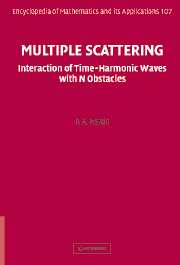Book contents
- Frontmatter
- Contents
- Preface
- 1 Introduction
- 2 Addition theorems in two dimensions
- 3 Addition theorems in three dimensions
- 4 Methods based on separation of variables
- 5 Integral equation methods, I: basic theory and applications
- 6 Integral equation methods, II: further results and applications
- 7 Null-field and T-matrix methods
- 8 Approximations
- Appendices
- References
- Citation index
- Subject index
1 - Introduction
Published online by Cambridge University Press: 06 July 2010
- Frontmatter
- Contents
- Preface
- 1 Introduction
- 2 Addition theorems in two dimensions
- 3 Addition theorems in three dimensions
- 4 Methods based on separation of variables
- 5 Integral equation methods, I: basic theory and applications
- 6 Integral equation methods, II: further results and applications
- 7 Null-field and T-matrix methods
- 8 Approximations
- Appendices
- References
- Citation index
- Subject index
Summary
Privately, [Rayleigh] often quoted with relish a saying attributed to Dalton when in the chair at a scientific meeting: “Well, this is a very interesting paper for those that take any interest in it”.
(Strutt [1157, p. 320])What is ‘multiple scattering’?
The mathematics of the full treatment may be altogether beyond human power in a reasonable time; nevertheless …
(Heaviside [489, p. 324])‘Multiple scattering’ means different things to different scientists, but a general definition might be ‘the interaction of fields with two or more obstacles’. For example, a typical multiple-scattering problem in classical physics is the scattering of sound waves by two rigid spheres. Further examples, such as the scattering of spherical electron waves by a cluster of atoms, can be found in condensed-matter physics [1379, 168, 422, 424, 423]. Many other examples will be discussed in this book.
The waves scattered by a single obstacle can be calculated in various well-known ways, such as by the method of separation of variables, T-matrix methods or integral-equation methods. All of these methods will be discussed in detail later.
If there are several obstacles, the field scattered from one obstacle will induce further scattered fields from all the other obstacles, which will induce further scattered fields from all the other obstacles, and so on. This recursive way of thinking about how to calculate the total field leads to another notion of multiple scattering; it can be used to actually compute the total scattered field – each step is called an order of scattering.
- Type
- Chapter
- Information
- Multiple ScatteringInteraction of Time-Harmonic Waves with N Obstacles, pp. 1 - 28Publisher: Cambridge University PressPrint publication year: 2006
- 2
- Cited by



